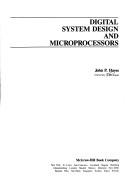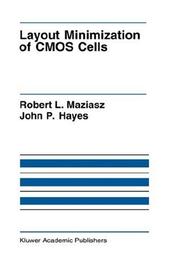| Listing 1 - 10 of 14 | << page >> |
Sort by
|

ISBN: 0070273669 Year: 1988 Publisher: New York (N.Y.) : McGraw-Hill,
Abstract | Keywords | Export | Availability | Bookmark
 Loading...
Loading...Choose an application
- Reference Manager
- EndNote
- RefWorks (Direct export to RefWorks)
Computer architecture. --- Electronic digital computers --- Design and construction.
Book
Year: 1988 Publisher: New York (etc.) : McGraw-Hill,
Abstract | Keywords | Export | Availability | Bookmark
 Loading...
Loading...Choose an application
- Reference Manager
- EndNote
- RefWorks (Direct export to RefWorks)
Book
Year: 1978 Publisher: Tokyo MacGraw-Hill Kogakusha
Abstract | Keywords | Export | Availability | Bookmark
 Loading...
Loading...Choose an application
- Reference Manager
- EndNote
- RefWorks (Direct export to RefWorks)

ISBN: 0070273677 Year: 1984 Publisher: New York (N.Y.) McGraw-Hill
Abstract | Keywords | Export | Availability | Bookmark
 Loading...
Loading...Choose an application
- Reference Manager
- EndNote
- RefWorks (Direct export to RefWorks)
Digital integrated circuits --- Logic design --- Microcomputers --- Microprocessors --- Programming
Book
ISBN: 1118069382 Year: 2006 Publisher: Hoboken, New Jersey : Wiley Publishing, Inc.,
Abstract | Keywords | Export | Availability | Bookmark
 Loading...
Loading...Choose an application
- Reference Manager
- EndNote
- RefWorks (Direct export to RefWorks)

ISBN: 0792391829 Year: 1992 Volume: SECS 160 Publisher: Boston : Kluwer Academic Publishers,
Abstract | Keywords | Export | Availability | Bookmark
 Loading...
Loading...Choose an application
- Reference Manager
- EndNote
- RefWorks (Direct export to RefWorks)
Book
ISBN: 9400791259 9048130646 9786612459405 1282459406 9048130654 Year: 2009 Publisher: Dordrecht : Springer Science,
Abstract | Keywords | Export | Availability | Bookmark
 Loading...
Loading...Choose an application
- Reference Manager
- EndNote
- RefWorks (Direct export to RefWorks)
Recent progress in atomic physics, semiconductors, and optical technologies lead to the need to control matter at an unprecedented scale. However, atoms, electrons and photons do not obey laws of classical physics and instead are governed by quantum mechanics. The formalism of quantum circuits promises to transform engineering disciplines the way digital circuits transformed computing, communications, control and measurement. A quantum circuit simulator implemented in software acts as a replacement of an actual quantum system and seeks to calculate the output from the inputs. This is a very difficult task, but researchers have achieved significant progress in many important special cases. This self-contained book discusses both theoretical and practical aspects of simulating quantum circuits on conventional computers. Engineers can sanity-check and evaluate their designs through simulation before building hardware. Computer scientists can use simulation to compare quantum algorithms to conventional ones. Quantum Circuit Simulation covers the fundamentals of linear algebra and introduces basic concepts of quantum physics needed to understand quantum circuits and algorithms. It requires only basic familiarity with algebra, graph algorithms and computer engineering. After introducing necessary background, the authors describe key simulation techniques that have so far been scattered throughout the research literature in physics, computer science, and computer engineering. Quantum Circuit Simulation also illustrates the development of software for quantum simulation by example of the QuIDDPro package, which is freely available and can be used by students of quantum information as a "quantum calculator.".
Algebras, Linear. --- Quantum theory. --- Algebras, Linear --- Quantum theory --- Algebra --- Electrical Engineering --- Electrical & Computer Engineering --- Mathematics --- Physical Sciences & Mathematics --- Engineering & Applied Sciences --- Quantum computers. --- Integrated circuits --- Mathematical models. --- Chips (Electronics) --- Circuits, Integrated --- Computer chips --- Microchips --- Engineering. --- Algorithms. --- Computer simulation. --- Applied mathematics. --- Engineering mathematics. --- Quantum physics. --- Spintronics. --- Electronic circuits. --- Circuits and Systems. --- Applications of Mathematics. --- Quantum Physics. --- Quantum Information Technology, Spintronics. --- Simulation and Modeling. --- Algorithm Analysis and Problem Complexity. --- Computers --- Electronic circuits --- Microelectronics --- Systems engineering. --- Mathematics. --- Computer software. --- Quantum dynamics --- Quantum mechanics --- Quantum physics --- Physics --- Mechanics --- Thermodynamics --- Math --- Science --- Engineering systems --- System engineering --- Engineering --- Industrial engineering --- System analysis --- Software, Computer --- Computer systems --- Computer modeling --- Computer models --- Modeling, Computer --- Models, Computer --- Simulation, Computer --- Electromechanical analogies --- Mathematical models --- Simulation methods --- Model-integrated computing --- Design and construction --- Algorism --- Arithmetic --- Fluxtronics --- Magnetoelectronics --- Spin electronics --- Spinelectronics --- Nanotechnology --- Engineering analysis --- Mathematical analysis --- Electron-tube circuits --- Electric circuits --- Electron tubes --- Electronics --- Foundations
Book
ISSN: 18761100 ISBN: 9048196434 9048196442 1283640775 9400797982 Year: 2013 Volume: v. 115 Publisher: New York : Springer,
Abstract | Keywords | Export | Availability | Bookmark
 Loading...
Loading...Choose an application
- Reference Manager
- EndNote
- RefWorks (Direct export to RefWorks)
Integrated circuits (ICs) increasingly exhibit uncertain characteristics due to soft errors, inherently probabilistic devices, and manufacturing variability. As device technologies scale, these effects can be detrimental to the reliability of logic circuits. To improve future semiconductor designs, this book describes methods for analyzing, designing, and testing circuits subject to probabilistic effects. The authors first develop techniques to model inherently probabilistic methods in logic circuits and to test circuits for determining their reliability after they are manufactured. Then, they study error-masking mechanisms intrinsic to digital circuits and show how to leverage them to design more reliable circuits. The book describes techniques for: • Modeling and reasoning about probabilistic behavior in logic circuits, including a matrix-based reliability-analysis framework; • Accurate analysis of soft-error rate (SER) based on functional-simulation, sufficiently scalable for use in gate-level optimizations; • Logic synthesis for greater resilience against soft errors, which improves reliability using moderate overhead in area and performance; • Test-generation and test-compaction methods aimed at probabilistic faults in logic circuits that facilitate accurate and efficient post-manufacture measurement of soft-error susceptibility.
Engineering. --- Logic circuits -- Design. --- Logic circuits -- Testing. --- Uncertainty (Information theory). --- Logic circuits --- Uncertainty (Information theory) --- Electrical & Computer Engineering --- Engineering & Applied Sciences --- Electrical Engineering --- Design --- Testing --- Logic circuits. --- Measure of uncertainty (Information theory) --- Shannon's measure of uncertainty --- System uncertainty --- Circuits, Logic --- Systems engineering. --- Computer science. --- Computer hardware. --- Operating systems (Computers). --- Logic design. --- Algebra --- Circuits and Systems. --- Arithmetic and Logic Structures. --- Computer Hardware. --- Performance and Reliability. --- Logic Design. --- Symbolic and Algebraic Manipulation. --- Data processing. --- Design, Logic --- Design of logic systems --- Digital electronics --- Electronic circuit design --- Machine theory --- Switching theory --- Computer operating systems --- Computers --- Disk operating systems --- Systems software --- Informatics --- Science --- Engineering systems --- System engineering --- Engineering --- Industrial engineering --- System analysis --- Operating systems --- Design and construction --- Information measurement --- Probabilities --- Questions and answers --- Electronic circuits --- Interface circuits --- Switching circuits --- Circuits --- Electronic circuits. --- Arithmetic and logic units, Computer. --- Computer software—Reusability. --- Computer science—Mathematics. --- Arithmetic and logic units, Computer --- Computer arithmetic --- Electronic digital computers --- Electron-tube circuits --- Electric circuits --- Electron tubes --- Electronics
Digital
ISBN: 9789048130658 Year: 2009 Publisher: Dordrecht Springer Science+Business Media B.V
Abstract | Keywords | Export | Availability | Bookmark
 Loading...
Loading...Choose an application
- Reference Manager
- EndNote
- RefWorks (Direct export to RefWorks)
Complex analysis --- Quantum mechanics. Quantumfield theory --- Spectrometric and optical chemical analysis --- Electrical engineering --- Artificial intelligence. Robotics. Simulation. Graphics --- quantumfysica --- electron spin resonance spectre --- complexe analyse (wiskunde) --- vormgeving --- simulaties --- informatietechnologie --- elektrische circuits
Digital
ISBN: 9789048196449 Year: 2013 Publisher: Dordrecht Springer Netherlands
Abstract | Keywords | Export | Availability | Bookmark
 Loading...
Loading...Choose an application
- Reference Manager
- EndNote
- RefWorks (Direct export to RefWorks)
Integrated circuits (ICs) increasingly exhibit uncertain characteristics due to soft errors, inherently probabilistic devices, and manufacturing variability. As device technologies scale, these effects can be detrimental to the reliability of logic circuits. To improve future semiconductor designs, this book describes methods for analyzing, designing, and testing circuits subject to probabilistic effects. The authors first develop techniques to model inherently probabilistic methods in logic circuits and to test circuits for determining their reliability after they are manufactured. Then, they study error-masking mechanisms intrinsic to digital circuits and show how to leverage them to design more reliable circuits. The book describes techniques for: • Modeling and reasoning about probabilistic behavior in logic circuits, including a matrix-based reliability-analysis framework; • Accurate analysis of soft-error rate (SER) based on functional-simulation, sufficiently scalable for use in gate-level optimizations; • Logic synthesis for greater resilience against soft errors, which improves reliability using moderate overhead in area and performance; • Test-generation and test-compaction methods aimed at probabilistic faults in logic circuits that facilitate accurate and efficient post-manufacture measurement of soft-error susceptibility.
Mathematical logic --- Logic --- Algebra --- Mathematics --- Electrical engineering --- Applied physical engineering --- Production management --- Computer science --- Computer architecture. Operating systems --- algebra --- betrouwbaarheid --- computers --- informatica --- ontwerpen --- hardware --- OS (operating system) --- ingenieurswetenschappen --- logica --- computerkunde --- elektrische circuits
| Listing 1 - 10 of 14 | << page >> |
Sort by
|

 Search
Search Feedback
Feedback About UniCat
About UniCat  Help
Help News
News